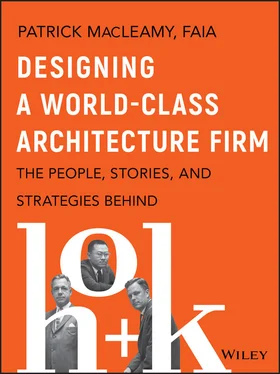1 ...7 8 9 11 12 13 ...19 HOK landed its first substantial commission in 1961, a new campus for Southern Illinois University in Edwardsville, Illinois, across the Mississippi River from St. Louis. The project required establishment of an Illinois office, and the firm's first, modest attempt at geographic diversification was underway.
Chapter 2: To Design a World-Class Firm
1 Open shop in a location where you have deep connections. Then, emphasize the name of the founder who has the most local contacts in that area.
2 Don't be afraid of large projects, including urban planning of entire towns.
3 Find and follow your own true talents, which may mean becoming a project manager or project architect instead of a designer.
4 Look for the potential to do great work even when designing ordinary buildings.
5 Contemplate how differences among you and your partners can be strengths, not weaknesses.
6 Be ambitious even if it means setting strategic goals that will take decades to come to fruition.
7 Do the right thing, always.
8 Remember that teams win through teamwork, not because of individual stars.
1 1Liam Otten, “A Challenge to Democracy Explores Legacy of Japanese Internment Camps | The Source | Washington University in St. Louis.” The Source, May 16, 2017. Accessed April 18, 2019. https://source.wustl.edu/2009/09/a-challenge-to-democracy-explores-legacy-of-japanese-internment-camps.
2 2Ibid.
3 3Cathy Sivek, “An Interview with Gyo Obata, FAIA, Founding Partner of Global Architectural Firm HOK,” ArchitectureSchools.com, February 2, 2006. Accessed April 21, 2019. http://architectureschools.com/resources/an-interview-with-Obata-obata-faia-founding-partner-of-global-architectural-firm-hok.
4 4Ibid.
5 5Frank Peters, “Art and Politics in the Dawn of Architectural Stardom,” St. Louis Post-Dispatch, February 23, 1986.
6 6Tim Woodcock, “The History of Lambert Airport,” St. Louis Magazine, August 22, 2014. Accessed April 21, 2019. https://www.stlmag.com/news/jet-age-design.
CHAPTER 3 Innovate Early and Often
HOK was just 12 years old when I joined in 1967, with 150 people in two offices and a growing list of varied design commissions in St. Louis and elsewhere. Innovation had become a core value at HOK, and I could see it everywhere.
I had never worked in a large, innovative firm before. The six-man practice in the Alton area, where I had spent summers, was a typical small firm. For example, when the firm won a new school project, the junior partner came up with a design. But when it came time to add details to the design—things like how the windows, doors, and lobby should look—the chief draftsman pulled drawings of the last school project from a drawer and assigned other draftsmen, including me, to trace over the old details to make details for the new school. The result was that most schools looked much the same. Innovation was absent at the firm and in its work.
Small firms followed the methods of the past, practicing an ongoing craft that carried forward from one project to the next. They drew everything by hand, in pencil, on vellum—a translucent paper used for drafting. The only machines in the typical small architecture office were telephones, a coffee machine, a typewriter for the secretary, and a printer for large drawings.
By contrast, when I arrived at HOK, innovation was encouraged—and expected—of everyone.
George Hellmuth loved marketing—and loved winning even more. He was a natural salesman—earthy, flamboyant, and fearless, especially when reaching out to top client leaders. He organized HOK's marketing operation around his personal style. He once said, “I know a lot about design; I've won prizes in it. But I never pleased myself with what I designed. I would rather use what I know to hire a damned good designer, then go out and land jobs for him.” 1
Prospecting for leads and finding potential new projects came first. Hellmuth subscribed to numerous clipping services, gathering bits of material from newspapers and magazines around the country. He and his long-time secretary, Dorothy Forrest, sifted through clippings every week, deciding which clients or projects were most likely to bear fruit. Then he wrote a letter to each, asking for an introductory meeting.
Hellmuth also maintained contacts with past clients, calling them on the phone or taking them to lunch. This is worth emulating. After all, if you've done your job right, past clients already like you and your work. Hellmuth would pepper them with questions: “What do you need? How can we help? Who from your company should I see? Can you introduce me?” He was happiest when on the hunt for a new project and took full advantage of the new age of air travel, flying to meet clients in other cities. Hellmuth made regular trips to Washington, DC to meet members of Congress and federal agencies. Sometimes he impressed faraway clients by just showing up at their offices. In this age of email, showing up in person makes even more of an impression.
Many architects thought meetings with potential clients were opportunities to talk about themselves and show off their work. Hellmuth was different. He believed the secret to winning work was being sincerely interested in the client—understanding the project from their point of view. Clients understood their own businesses, but little about the process of designing and building. By listening carefully, Hellmuth gained an understanding of what was most important to a client, and only then would he respond with how HOK could help their project be successful. Know this: Great marketers listen before they talk.
Hellmuth had another weapon in his sales arsenal—he was not above using flattery. When talking with a potential client, he was always complimentary, and once remarked, “Never underestimate the effect of flattery on even very important people.” 2
Some large government and corporate clients leave selection of the architect to committees of midlevel officials whose careers often depend on making the right choice. What if they pick the wrong architect and the building ends up overbudget? What if the finished building is not functional? What if the design is viewed unfavorably by their superiors? Hellmuth understood the pressures these officials faced, and spent time reassuring them, staying in touch as new concerns surfaced. He became their friend and advisor, gaining their trust as they made the final choice of an architecture firm—ideally HOK.
How do you convince a client you can design a type of building you have not designed before? This is the most difficult selling job in architecture and Hellmuth loved the challenge. He cultivated sincere friendships with clients, and sometimes the bond of friendship became a substitute for prior experience. Sometimes Hellmuth won over clients by emphasizing the opportunity for a fresh look from the imagination of his design partner Obata. Sometimes Hellmuth brought Obata along, and Obata would impress clients with his careful, listening approach. At other times, Hellmuth emphasized the large size of HOK, and the people and resources he could bring to the work. By the time I joined, in 1967, HOK had become one of the largest design firms in the country, with a deep pool of talented people ready to take on particularly challenging projects.
Another hurdle Hellmuth faced was winning work outside of St. Louis in cities where HOK had no exposure. For architects, geographic expansion is hard . Clients naturally favor local architects—public clients, especially, when local tax money is involved. Local clients need compelling reasons to hire an architect from out of town, reasons strong enough to overcome their preference for spreading the wealth to local businesses. Sometimes a strong design reputation was enough to win the job. At other times, depth of experience in the building type was necessary.
Читать дальше












